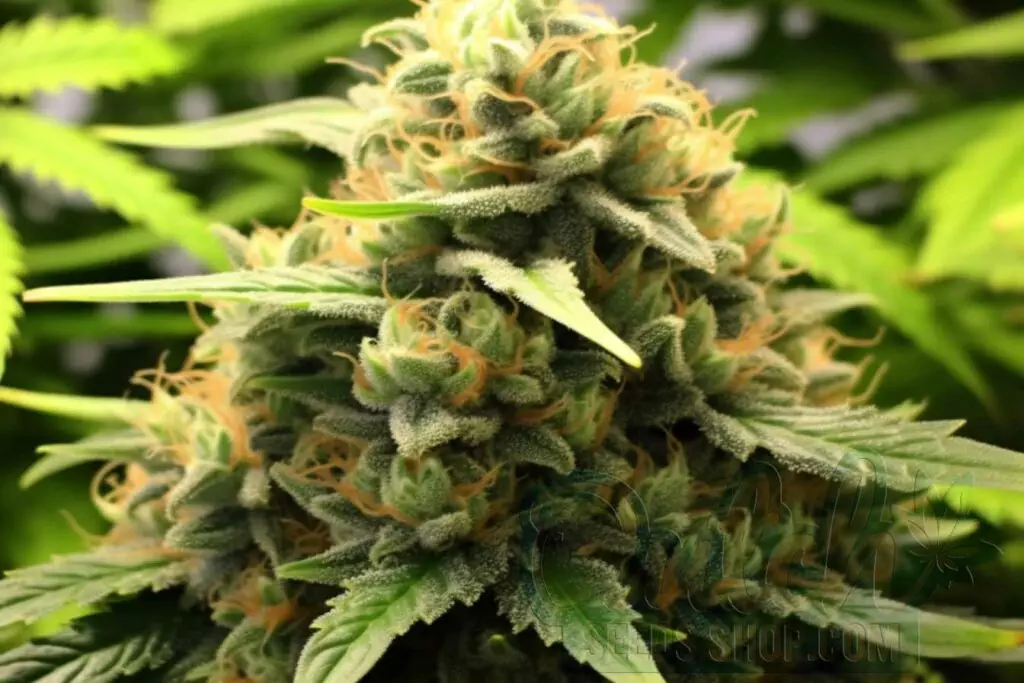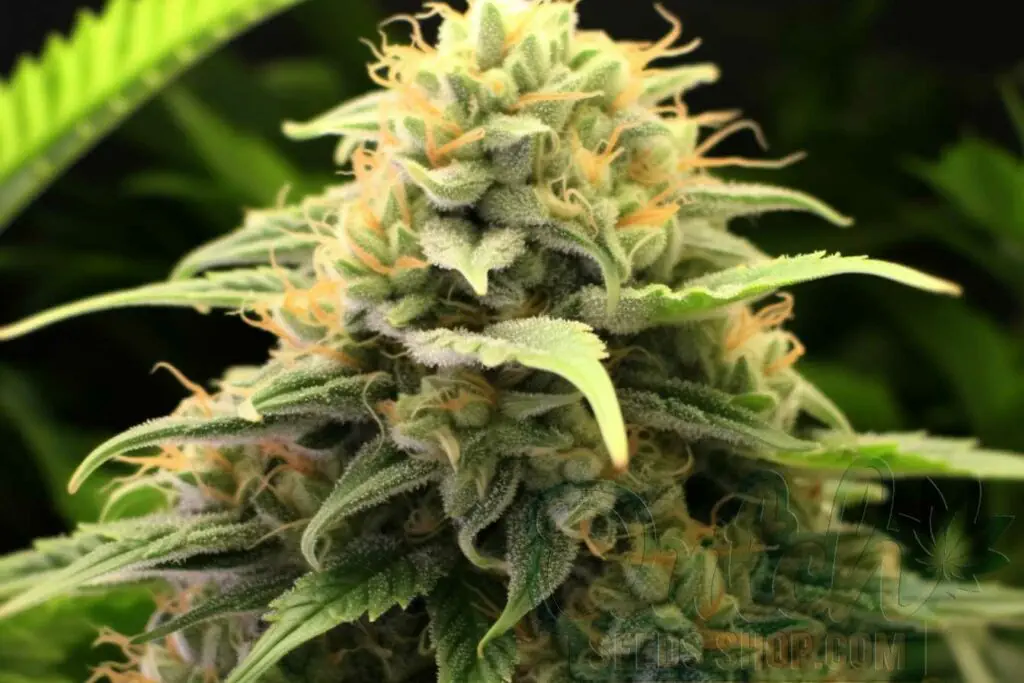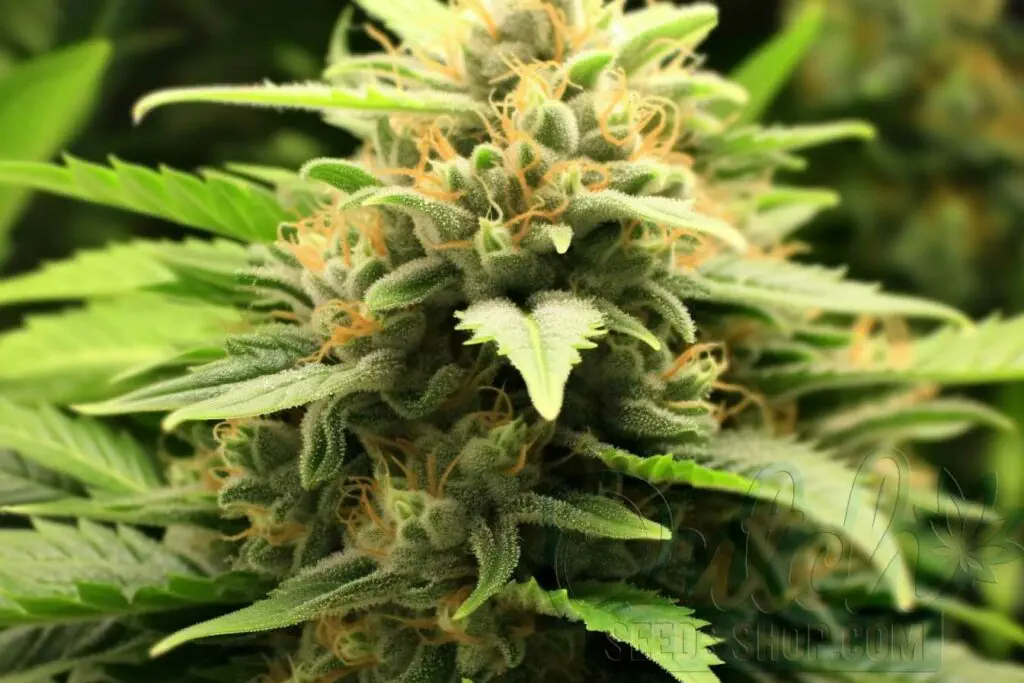Stardawg Marijuana Strain Information and Review
Stardawg, a standout strain in the cannabis world, is revered for its potent blend of effects and flavors. This strain is a fascinating tapestry of genetics and terpenes, offering an experience that’s both invigorating and soothing.

Type: 20% Indica / 80% Sativa
Genetic: Chemdog 4 x Tres Dawg
THC: 18 – 22%
CBD: 0.1 – 1%
Terpenes: Caryophyllene, Limonene, Myrcene, Pinene
Flowering Time: 56 – 63 days
Indoor Yield: 1.3 – 1.6 oz/ft²
Outdoor Yield: 21 – 28 oz/plant
Effects: Creative, Energetic, Happy, Relaxed
Flavors/Taste: Diesel, Earthy, Pungent, Sour
It’s a go-to choice for those seeking a balanced high with a complex flavor profile.
In this comprehensive review, we’ll explore everything from Stardawg’s lineage and history to its growing characteristics, delving into what makes this strain both a favorite among connoisseurs and a reliable choice for medicinal users.
Key Takeaways:
- Stardawg is a sativa-dominant hybrid, resulting from crossing Chemdog 4 and Tres Dawg, known for its uplifting and creative effects.
- The strain features a complex terpene profile with dominant notes of myrcene and limonene, contributing to its earthy, sour, and diesel flavors.
- Stardawg’s THC content ranges from 18% to 22%, with CBD levels below 1%, making it a potent choice for recreational use.
- Commonly reported effects of Stardawg include feelings of happiness, relaxation, and energy, suitable for daytime use.
- Medical benefits of Stardawg include relief from stress, depression, and fatigue, although it may cause dry mouth and eyes.
- Stardawg can be grown both indoors and outdoors, with a moderate difficulty level and a flowering time of 56 to 63 days.
- Indoor yields for Stardawg range from 1.3 to 1.6 oz/ft², while outdoor plants can yield 21 to 28 oz per plant.
Stardawg Strain Genetics
The genetics of Stardawg are a testament to expert breeding and a deep understanding of cannabis’s potential.
By combining Chemdog 4 and Tres Dawg, breeders have created a strain that shines in its complexity and versatility.
This hybrid not only embodies the best of its parent strains but also stands out for its unique characteristics.
In this section, we’ll explore the genetic makeup of Stardawg, examining its origins, history, and the factors that contribute to its popularity.
Origins and Lineage
Stardawg owes its robust genetic profile to its parent strains, Chemdog 4 and Tres Dawg.
Chemdog 4 is known for its balanced effects and distinctive aroma, while Tres Dawg brings in the depth of flavor and potency.
This combination has resulted in a strain that leans heavily towards sativa, providing an energetic and uplifting experience.
Stardawg’s lineage is a blend of the best qualities of its ancestors, offering a perfect mix of euphoria and relaxation.
History
The history of Stardawg is as rich and varied as its effects.
Emerging from a lineage of legendary strains, Stardawg has carved out its own niche in the cannabis community.
Its evolution from a crossbreeding experiment to a beloved staple in dispensaries is a story of careful selection and adaptation.
Over time, Stardawg has gained a reputation for its consistent quality and powerful effects, making it a sought-after strain for both recreational and medicinal purposes.
Appearance of Stardawg Weed
Stardawg’s appearance is as striking as its effects.
The buds are typically medium in size and boast a dense, compact structure.
A closer look reveals a kaleidoscope of colors, from deep greens to hints of purple, all covered in a generous coating of crystal trichomes.
These trichomes not only add to the visual appeal but also signify the strain’s potency.
- Color: Deep Green with Purple Hues
- Bud Structure: Compact and Dense
- Trichomes: Abundant and Crystal-like
Is Stardawg Indica or Sativa?

Stardawg is primarily categorized as a sativa-dominant hybrid, with its genetic makeup consisting of approximately 80% sativa and 20% indica.
This sativa dominance is evident in the strain’s energizing and cerebral effects, making it ideal for daytime use.
The indica component, although lesser, contributes to the relaxing undertones, providing a balanced experience that appeals to a broad range of users.
Cannabinoids and Terpenes
The chemical composition of Stardawg plays a pivotal role in its unique properties and effects.
This strain’s cannabinoid and terpene profiles are a symphony of elements that contribute to its distinct aroma, flavor, and therapeutic benefits.
The intricate balance of THC and CBD, coupled with a rich terpene profile, makes Stardawg a multifaceted strain suitable for a variety of users.
Let’s delve into the specifics of these compounds and understand how they shape the Stardawg experience.
Terpenes Profile
Stardawg’s terpene profile is a complex tapestry that significantly influences its sensory and therapeutic qualities.
Here are the predominant terpenes in Stardawg and their respective roles:
- Myrcene: Imparts an earthy and herbal aroma, contributing to the strain’s relaxing effects.
- Limonene: Offers a citrusy undertone, known for mood elevation and stress relief.
- Caryophyllene: Provides a spicy and peppery note, playing a role in pain relief.
- Pinene: Adds a pine-like freshness, potentially aiding in memory retention and alertness.
THC and CBD levels
The THC and CBD levels in Stardawg are a defining characteristic of the strain.
With THC levels ranging from 18% to 22%, Stardawg stands out as a potent option for those seeking a strong psychoactive experience.
On the other hand, its CBD content is below 1%, which is typical for strains that prioritize recreational effects over medicinal.
| Cannabinoid | Level |
| THC | 18%-22% |
| CBD | <1% |
Aroma and Flavor
Stardawg’s aroma and flavor profile is a complex blend that tantalizes the senses.
The strain greets you with a pungent diesel smell, immediately indicating its potency.
On closer inspection, one can detect earthy and sour undertones, adding depth to its olfactory profile.
The flavor mirrors this complexity, with a pronounced diesel taste complemented by earthy and sour notes.
This intricate blend of aromas and flavors makes Stardawg a memorable and enjoyable experience for both new and seasoned users.
Stardawg Strain Effects and Medical Benefits
Stardawg’s effects are as diverse as its genetic background, making it a versatile strain for various users.
Whether you’re seeking relief from medical conditions or simply looking to enjoy a recreational high, Stardawg offers a range of benefits.
This section explores the feelings and medical advantages that Stardawg strain brings, along with some of the potential negatives.
Feelings

Consuming Stardawg results in a spectrum of effects that cater to both the body and mind.
Users often report an initial rush of energy and creativity, making it suitable for artistic endeavors or social gatherings.
This is followed by a sense of relaxation and happiness, which is not overwhelming but pleasantly soothing.
The balance between euphoria and calmness makes Stardawg a popular choice for daytime use, providing a boost without the lethargy associated with some strains.
Negatives
While Stardawg offers numerous benefits, it’s not without its drawbacks.
The most commonly reported negative effects include dry mouth and dry eyes, a typical response to high-THC strains.
Some users might also experience mild anxiety or paranoia, especially at higher doses.
These side effects are generally manageable and do not detract significantly from the overall positive experience.
Stardawg Strain Helps With
Stardawg has proven effective in alleviating various medical symptoms.
Its uplifting and energizing effects can help combat fatigue and depression, while its relaxing properties may provide relief from chronic pain and stress.
Additionally, it has been known to aid those suffering from mood disorders, offering a sense of well-being and balance.
Growing Stardawg
Growing Stardawg is an endeavor that rewards cultivators with high-quality, potent buds.
This strain’s moderate growing difficulty makes it suitable for both novice and experienced growers.
Understanding the specific requirements of Stardawg, from seed selection to harvesting, is crucial for achieving optimal results.
In this section, we delve into the details of growing Stardawg strain, covering everything from seed types to cultivation techniques, feeding, and expected yields.
Stardawg Seeds
When it comes to selecting Stardawg seeds, growers have options: regular, feminized, and autoflowering.
Regular seeds produce both male and female plants, offering a traditional cultivation experience.
Feminized seeds are bred to produce only female plants, ensuring a higher yield of usable buds.
Autoflowering seeds are ideal for those seeking a faster and more straightforward growing process, as these plants automatically switch from vegetative to flowering stage without the need for a change in light cycle.
Growing Guide
Cultivating Stardawg requires an understanding of its specific needs and growing conditions.
This guide provides a foundation for growers to achieve the best results, whether growing indoors or outdoors.
Key factors such as light, temperature, humidity, and feeding will be discussed, ensuring that your Stardawg plants thrive and produce quality yields.
Indoor and Outdoor Growing Info
Indoor growing of Stardawg allows for more control over environmental factors like light, temperature, and humidity.
This control often leads to higher quality buds, with yields ranging from 1.3 to 1.6 oz/ft².
On the other hand, outdoor growing can result in larger plants and potentially higher yields, up to 21 to 28 oz per plant, but it requires a mild climate and more space.
Feeding Stardawg Plants
A balanced feeding regimen is crucial for the optimal growth of Stardawg.
During the vegetative stage, a higher nitrogen content is beneficial, while the flowering stage requires more phosphorus and potassium.
Regular monitoring of pH levels in the soil or hydroponic solution is essential for nutrient uptake.
Flowering Time and Yield of Stardawg Seeds

Stardawg’s flowering time typically ranges from 56 to 63 days.
The yield varies based on growing conditions, with indoor plants producing about 1.3 to 1.6 oz/ft² and outdoor plants yielding 21 to 28 oz per plant.
Growers should watch for the characteristic trichome development to determine the optimal harvest time.
Comparison of Alternative Strains to Stardawg Strain
When comparing Stardawg to other strains, it’s important to consider factors like potency, flavor profile, and growing characteristics.
Here’s a comparison table for Stardawg and similar strains:
| Strain | Potency | Flavor Profile | Growing Difficulty | Yield |
| Stardawg | High (18%-22% THC) | Diesel, Earthy, Sour | Moderate | Indoors: 1.3-1.6 oz/ft², Outdoors: 21-28 oz/plant |
| Purple Stardawg | Moderate-High | Grape, Berry, Diesel | Moderate | Comparable to Stardawg |
| Black Skull | Moderate | Sweet, Spicy | Easy | Slightly lower than Stardawg |
| Chocolate Stardawg | High | Chocolate, Coffee | Moderate-Hard | Similar to Stardawg |
| Strawberry StarDawg | High | Strawberry, Sweet | Moderate | Comparable to Stardawg |
FAQ
Is Stardawg suitable for beginners?
Stardawg’s moderate growing difficulty makes it a feasible option for beginners who are willing to invest time in learning about its specific cultivation needs.
How long does it take to grow Stardawg?
Stardawg typically requires about 56 to 63 days of flowering time, with additional time for the vegetative stage.
Can Stardawg be grown outdoors?
Yes, Stardawg can be grown outdoors, ideally in a mild climate.
What are the medical benefits of Stardawg?
Stardawg is known to help with conditions like stress, depression, and fatigue, due to its uplifting and energizing effects.
About the Author
